2021 Middleweight Adventure Bike Spec Shootout

The year's hottest middleweight adventure bikes battle it out - on paper
No category in motorcycling right now is as hot as the middleweight adventure bike category, with the flames ignited by the likes of the KTM 890 Adventure R and Yamaha Tenere 700. Two very different motorcycles with one common objective, the MO crew has finally been able to gather the KTM and Yamaha together for a right ‘ol shootout. While we were at it, we brought the BMW F850GS Adventure, Moto Guzzi V85 TT Travel, and Triumph Tiger 900 Rally Pro along for the ride in a classic MO extravaganza.
In lieu of our most anticipated shootout of the year, which has just concluded by the time you read this, we’ll whet your appetite with some bench racing based on all the bike’s specs. While you at home don’t realize it, the actual riding portion of this test has been several months in the making, dating back well into 2020. Several obstacles and delays meant gathering all the bikes together at the same time was much more of a pain in the arse than we could have ever imagined, but here we are. Finally.
Since you probably don’t want to know how the sausage is made, we’ll jump right into this war of specs, breaking each bike down by certain categories and telling you where they stack up. So, let’s begin.
Engine
There are some interesting observations when it comes to each respective engine. We mostly have Twins here, but they’re widely different. The KTM and Yamaha have parallel-Twins but they’re on the opposite ends of the displacement spectrum. At 889cc, the 890 Adventure R has the biggest engine in this test, then at the opposite end is the Yamaha’s 689cc Twin. The Moto-Guzzi and BMW slot in the middle, both with the same 853cc, but the Guzzi is the odd one out with its longitudinally opposed Twin that’s also air-cooled. Two of its distinct features. The F850GS is more traditional with its liquid-cooled, parallel-Twin layout. Then we have the 888cc Triple from Triumph. The outlier in the group, the Triumph comes in one cubic centimeter smaller than the KTM.
Despite having one cylinder less than the Triumph, the KTM rockets to the lead in the horsepower war with nearly 93 horses at 8300 rpm and 64 lb-ft. at 7100 rpm. Hot on its heels is the Triumph with 85.5 horsepower at 8800 rpm, and 58.8 lb-ft. of torque at 7200 rpm. Next is the BMW with a tick over 77 horses and 56 lb-ft, and then the Yamaha. Unsurprisingly with its smallest size, it also makes the least power: nearly 64 horsepower and 44 lb-ft.
If you’re wondering about the Guzzi, so are we. Remember that bit in the beginning about all these bikes being hard to gather in the same place and at the same time? One of the casualties of this unfortunate timing was the fact we couldn’t get the Guzzi in time for our date with the dyno. The best we have is Guzzi’s claimed figures of 80 horsepower and 59 lb-ft, respectively. Factor in roughly 15% in driveline losses and you’re looking at horsepower numbers in the high 60s and torque right around 50 lb-ft to the rear wheel – putting it on par with the Yamaha.
Suspension/Brakes/Tires
As we know, power isn’t everything (even though, in the case of middleweight adventure bikes, it’s kind of a big deal). You need a chassis underneath you to harness the power effectively. Long heralded as having this off-road thing down, the KTM brings to the party the fully-adjustable XPLOR suspension package featuring a 48mm inverted fork and a single shock, both with 9.4 inches of travel – the most of any bike in this test. Rolling on a 21-inch/18-inch wheel set, its off-road intentions are clear.
At the other end of the spectrum is the Moto Guzzi. Its 41mm fork is the smallest in this test, and while it’s also inverted, it only gives adjustment for spring preload and rebound damping. A similarly adjustable single shock sits in the back, and both provide only 6.7 inches of travel. The V85 rides on a 19-inch front wheel and 17-inch rear, which limits its off-road tire choices. Clearly meant for different kinds of off-roaders, the Guzzi satisfies on-road with the occasional light off-road jaunt, while the 890 Adventure dares its rider to find the path with the most dirt.
Slotting in between the KTM and Moto Guzzi, we have the BMW’s 43mm fork and single shock, the rear adjustable for spring preload and rebound damping. In the case of the model tested here, the F850 GS Adventure is equipped with BMW’s electronic suspension adjustment (ESA) allowing the shock’s preload to be adjusted with the left switchgear. The optional ESA shock also monitors speed and terrain adjusting damping rates by the millisecond while riding. You get 8 inches of travel up front and 8.6 inches at the rear. A 21/17 wheel combo also gives you lots of rubber options depending on the on- or off-road riding you intend to do.
The Triumph comes in with impressive components of its own. Showa provides the suspension here, with the 45mm inverted fork offering spring preload, rebound, and compression damping. The Showa shock, interestingly, doesn’t provide adjustment for compression damping but is otherwise similar. Travel is 9.45 inches and 9.06 inches front and rear, with a 21/17 wheel combo. While the KTM gets much of the off-road attention, it could be said that the Triumph has been making a case for itself as the sleeper in this category.
Then comes the Yamaha. The bare-bones Tenere 700 wears KYB components at both ends, with a 43mm fork and single shock. The front is fully adjustable and the rear offers spring preload and rebound damping. Suspension travel is 8.3 inches up front and 7.9 inches in the rear. Those aren’t great numbers compared to the competition, but ground clearance hasn’t been reported as one of its issues. A 21/18-inch wheelset gives it plenty of off-road tire options, too.
When it comes to stopping power, all the bikes here wear two discs up front. No real surprise there. But while the Yamaha wears 282 mm discs (by far the smallest of the group) and the BMW uses 305 mm discs, the KTM, Moto Guzzi, and Triumph all wear 320 mm discs mated to four-piston calipers. Basic ABS is available on all of them, but the Adventure R, Tiger 900, and our F850 test bike have Cornering-ABS as an option.
Electronics
The ABS topic brings up another distinguishing feature of all these bikes – their electronics. While these days it seems like you’re nothing without a sophisticated electronics package, Yamaha isn’t buying in. At least not with the Tenere 700, as it lacks everything other than electronic fuel injection and ABS. While this is likely appealing to many riders, others will be glad to know you’ll also find ride modes and traction control on the rest of the bikes here. Though their sophistication can vary widely.
Our KTM tester came with the Technology package, which includes the Rally Pack with different ride modes, cornering ABS, offroad ABS, lean-sensitive ABS and traction control. There’s also an up/down quickshifter and cruise control, too. And even though it has its own acronyms on the Triumph, the Tiger 900 has all the same capabilities as the KTM. The difference comes in the respective limits and settings each OEM places.
A BMW wouldn’t be a BMW without a lot of tech onboard, and our tester packs nearly everything BMW’s got. There’s Dynamic ESA (Electronic Suspension Adjustment), ABS Pro, DTC, Ride Modes Pro, quickshifter, and likely enough computing ability to put itself into orbit if it had rocket thrusters.
The V85 TT packs a modest punch compared to the others with “just” three riding modes, cruise control, traction control, and ABS (not lean sensitive). When it comes to keeping it simple, though, the Tenere 700 embodies the sentiment, with an LCD interface and a bar to mount your navigation notes. You know, Dakar-style.
Dimensions
Hitting that Goldilocks zone of power is what makes the middleweight adventure category so hot right now, as people realize they don’t need massive horsepower to have fun off-road. But the second reason this sector is so popular is the smaller physical dimensions these bikes have.
For many, seat height plays a big role with ADV bikes. With this lineup, the V85 provides the lowest seat, at 32.7 inches. From here the rest of the field are very close. The Triumph’s seat varies between 33.5-34.3 inches, the BMW’s seat is 34.4 inches, and both the Yamaha and KTM come in at 34.6 inches. Seat heights don’t tell the whole story when it comes to reaching the ground, as seat shapes and fuel tank shapes and volume splay the legs in different ways.
On the topic of fuel tanks, fuel capacity is also a big deal when fulfilling the touring part of the adventure-touring equation. On the small end we have the Yamaha’s 4.2-gallon tank. The KTM and Triumph both have 5.3-gallon tanks (though some of the KTM’s fuel is cleverly stored low, in front of the engine). Next is the V85 and its 5.5-gallon tank, followed by the F850GS Adventure with its huge 6.1-gallon tank. As for actual fuel economy, that’s something you’ll have to wait for in the shootout story.
Lastly, there’s weight. Lugging around as little weight as possible, especially off-road, is the goal. To this end, we put all the bikes on our own scales so we’re not reliant on the manufacturer’s claims (although, lately, they’ve been pretty close to our own numbers). The BMW comes in last with its 552-lb curb weight (surely its huge gas tank doesn’t help), followed by the 540-lb Moto Guzzi, and 503-lb Tiger 900. The real surprise here are the KTM and Yamaha. While the Tenere 700 is the lightest bike here at 468 lbs, the KTM is only one pound heavier. This despite the fact that it carries over a gallon more gas. Truly impressive stuff.
Price
The last appealing quality of the middleweight ADV class is its relatively affordable price compared to the heavyweights. Although, as we’ll soon see, no matter what class you’re in, prices can skyrocket once you add things to the options sheet.
At the top of the range, Triumph comes in at $17,100. Next comes the BMW at $14,545 – and that’s just the starting price. Any BMW follower knows a bare-bones model is next to impossible to find. As tested, our F850GS Adventure’s price tag is approximately $17,500. The KTM is in the middle of the pack at $14,199 ($14,750 as tested), then there’s the $13,390 Moto Guzzi. Sitting at the bottom of the price range is the $9,999 Yamaha Tenere 700. With its meager price, basic features, and huge capabilities, it’s no wonder why Yamaha’s poised to have a big seller on its hands.
However, there’s a case to be made for all of these bikes, which is exactly what we’re working on next. So, stay tuned for our big shootout test, coming soon.
2021 Middleweight ADV Specs | |||||
|---|---|---|---|---|---|
BMW F850GS Adventure | KTM 890 Adventure R | Moto Guzzi V85 TT Travel | Triumph Tiger 900 Rally Pro | Yamaha Tenere 700 | |
| MSRP | $14,545 (approx $17,500 as tested) | $14,199 ($14,750 as tested) | $13,390 | $17,100 | $9,999 |
| Engine Type | 853cc, Liquid-cooled, 4-stroke parallel twin engine | 889cc 2-cylinder, 4-stroke, Parallel-Twin, liquid-cooled with water/oil heat exchanger | 853cc Air-cooled longitudinally-mounted 90° V-Twin | 888cc Fuel-injected, liquid-cooled, 12-valve, DOHC, inline 3-cylinder | 689cc liquid-cooled Parallel Twin |
| Bore and Stroke | 84.0 mm x 77 mm | 90.7 mm x 68.8 mm | 84.0 mm x 77.0 mm | 78.0 mm x 61.9 mm | 80.0 mm x 68.6 mm |
| Fuel System | Electronic Fuel Injection | Bosch EMS with RbW, 46mm throttle bodies | Electronic injection; 52 mm single throttle body, Ride-by-Wire | Multi-point sequential electronic fuel injection | EFI |
| Compression Ratio | 12.7:1 | 13.5:1 | 10.5:1 | 11.27:1 | 11.5:1 |
| Valve Train | 4 valves per cylinder, DOHC, dry sump lubrication | DOHC, four-valve | OHC two valves per cylinder (titanium intake) | 12-valve, DOHC | DOHC; 8 valves |
| Peak HP | 77.2 hp @ 7700 rpm | 92.5 hp @ 8300 rpm | 80 hp at 7750 rpm (claimed) | 85.5 hp @ 8800 rpm | 63.7 hp @ 8900 rpm |
| Peak Torque | 56.1 lb-ft @ 5300 rpm | 64.1 lb-ft @ 7100 rpm | 59 lb-ft. @ 5000 rpm (claimed) | 58.8 lb-ft. @ 7200 rpm | 44.3 lb-ft. @ 6500 rpm |
| Transmission | 6-speed | 6-speed | 6-speed | 6-speed | 6-speed |
| Final Drive | Chain | 520 X-Ring Chain | Shaft | O-Ring Chain | Chain |
| Front Suspension | 43mm upside-down telescopic fork, 8.0 inches of travel | Fully-adjustable WP XPLOR-USD, 48 mm, 9.4 inches of travel | 41 mm hydraulic telescopic USD fork, with adjustable spring preload and hydraulic rebound, 6.7 inches travel | Showa 45 mm upside down forks, manual preload, rebound damping and compression damping adjustment, 9.45 inches travel | KYB 43mm inverted fork, fully-adjustable; 8.3-in travel |
| Rear Suspension | Cast aluminum 2-sided swing arm, WAD strut (travel related damping), spring pre-load hydraulically adjustable (continuously variable) at handwheel, rebound damping adjustable, 8.6 inches of travel | Fully-adjustable WP XPLOR monoshock, 9.4 inches of travel | Double-sided swingarm in box-type aluminum with a single shock on the right side, with adjustable spring preload and hydraulic rebound, 6.7 inches travel | Showa rear suspension unit, manual preload and rebound damping adjustment, 9.06 inches wheel travel | KYB Single shock, adjustable preload (w/remote adjuster) and rebound damping; 7.9-in travel |
| Front Brake | Dual floating disc brakes, two-piston floating calipers, diameter 305 mm | Dual 320 mm discs with radial-mount four-piston calipers | Double 320 mm stainless steel floating discs, Brembo radial-mounted calipers with 4 opposed pistons | Twin 320 mm floating discs, Brembo Stylema 4-piston monobloc calipers. Radial front master cylinder, Optimized Cornering ABS | Brembo Dual 282mm hydraulic disc; selectable ABS (on/off) |
| Rear Brake | Single disc brake, diameter 265 mm, single-piston floating caliper | 260 mm disc with two-piston floating caliper | 260 mm stainless steel disc, floating caliper with 2 pistons | Single 254 mm disc. Brembo single-piston sliding caliper. Optimized cornering ABS | Brembo 245mm hydraulic disc; selectable ABS (on/off) |
| Front Tire | 2.15 x 21″ / 90/90 – 21 | 90/90-21 Continental TKC 80 | 2.50” x 19” / 110/80-19 | 90/90-21 | 90/90R21 Pirelli Scorpion Rally STR |
| Rear Tire | 4.25 x 17″ / 150/70 – 17 | 150/70-18 Continental TKC 80 | 4.25” x 17” / 150/70-17 | 150/70R17 | 150/70R18 Pirelli Scorpion Rally STR |
| Rake/Trail | 28° / 4.9 in. (124.5mm) | 26.3° / NA | 28°/ 5.04 in. (128.0mm) | 24.4º/5.7 in. (144.8mm) | 27.0º/4.13 in. (104.9mm) |
| Wheelbase | 62.7 in. | 60.2 in. | 60.2 in. | 61.1 in. | 62.8 in. |
| Seat Height | 34.4 in. | 34.6 in. | 32.7 in. | 33.5-34.3 in. | 34.6 in. |
| Curb Weight | 552 lbs. | 469 lbs. | 540 lbs. | 503 lbs. | 468 lbs. |
| Fuel Capacity | 6.1 gal. (23 liters) | 5.3 gal. | 5.5 gal (including 1.3-gal reserve) | 5.3 gal. | 4.2 gal. |
| Observed MPG | 36.5 mpg | 43.7 mpg | 38.6 mpg | 44.2 mpg | 38.1 mpg |

Troy's been riding motorcycles and writing about them since 2006, getting his start at Rider Magazine. From there, he moved to Sport Rider Magazine before finally landing at Motorcycle.com in 2011. A lifelong gearhead who didn't fully immerse himself in motorcycles until his teenage years, Troy's interests have always been in technology, performance, and going fast. Naturally, racing was the perfect avenue to combine all three. Troy has been racing nearly as long as he's been riding and has competed at the AMA national level. He's also won multiple club races throughout the country, culminating in a Utah Sport Bike Association championship in 2011. He has been invited as a guest instructor for the Yamaha Champions Riding School, and when he's not out riding, he's either wrenching on bikes or watching MotoGP.
More by Troy Siahaan



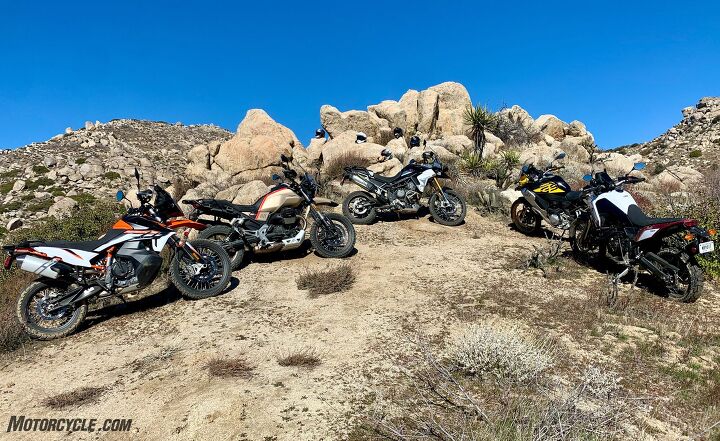


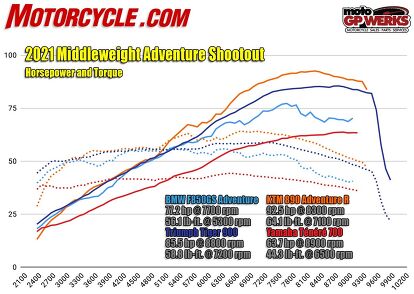








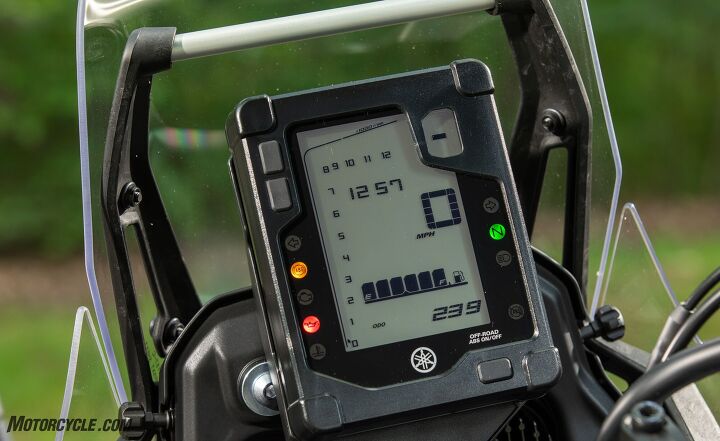

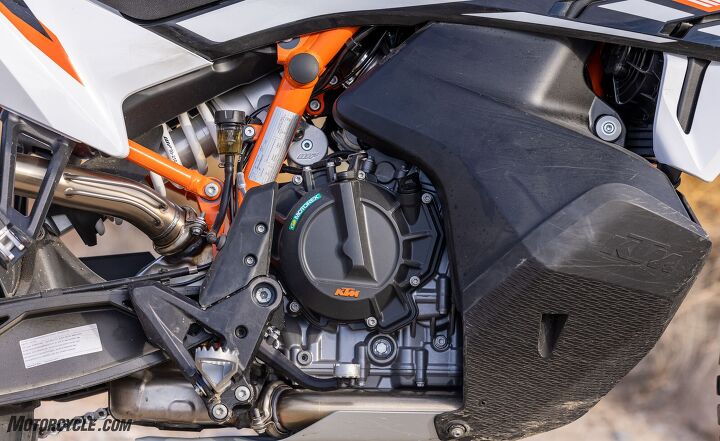









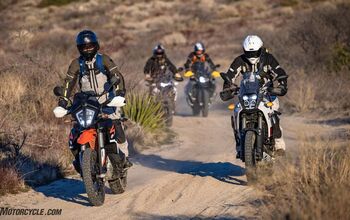
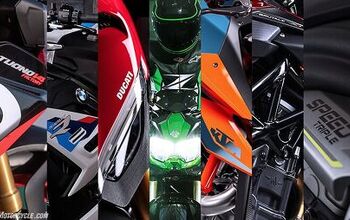
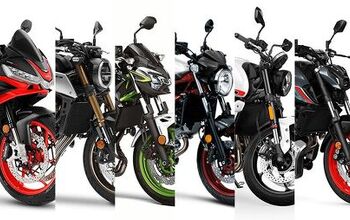
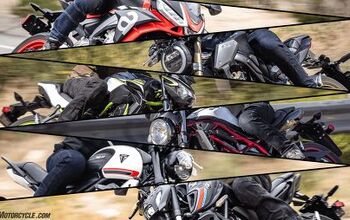












Comments
Join the conversation
The revised KLR650 would be at the top of my list. Lots of adventure for the buck. I still think of it as being big but it would be a small ADV bike in this test.
It's interesting to see and read comments on pricing, and while I disputed this early on a few years ago when we started to see mid-sized price creep due to features that these would sell (think Mutistrada 950, Tigers always, and the F850s), and okay to report I was wrong. I think this industry is in a weird spot. Power still matters, but to fewer people. I'd rather have a well equipped, moderately powered bike over a well equipped high powered bike, even if I'm paying close to "big bike" prices. You're paying for the electronic R&D, which doesn't decrease in cost just because you halfed the engine. I'm far more capable on my RS660 that I ever was on the RSV4, and you can snatch left overs of the latter for only a few $K more, or a gently used one for the same price.
We're all starting to come around to what the journos have been saying for a while; get the components right and you get the bike right.